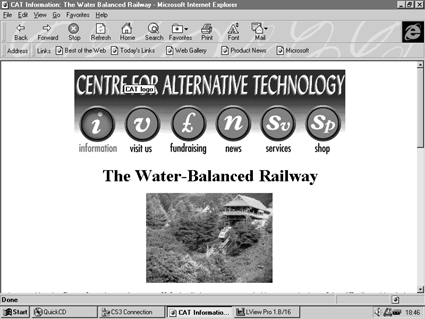Down Your Way: Centre for Alternative Technology
There cannot be too many information services that are reached by means of a water balanced cliff railway, nor can there be many that operate from a former slate quarry. What is more, the regenerative design of the railway system and its method of computer control offer an appropriate introduction to the principles behind the Centre for Alternative Technology (CAT) near the town of Machynlleth in mid Wales. The Centre’s genesis was in the seventies, when a group of enthusiasts set out to create a “living community to test the emerging technologies, finding out which ones worked and which ones didn’t”. In just over 20 years the enterprise has grown so that, based now on a plc and with charitable status, it has a mature programme of research and public education in the practical application of what the staff today prefer to call sustainable technology.
Behind the residential courses and the steadily increasing flow of visitors looking at the low energy self-build house, the solar powered phone box, the wind turbines, the organic gardens, the reed beds and the solar roofing there is a serious purpose. This is reflected in the research programmes, web site developments, publications and the conventional information services. With Cardiff University, the CAT has recently completed a joint research project, locally called “The Roof” but more properly known as the Large-scale Photovoltaic-integrated Roof. The photovoltaic modules used form a waterproof layer, eliminating the need for separate waterproofing. The design has unique features, and as well as helping to meet the energy needs of the Centre it also sells surplus electricity to the National Grid. Research into landfill sites is currently being carried out in collaboration with Powys County Council, and other activities are being grant-aided by the DTI and the Millennium Commission. The latter is supporting a programme of Gaia theory research. Paul Allen, in charge of Publicity, says “Most of our work is interpretative, but this has to be backed up by information. Our own web site contains most of the organisational information, and we have won a DTI prize for our virtual site, but the web is also the best way to keep up to date with current developments in ecology throughout the entire world.” Over the year, the site (http://www.cat.org.uk) averages 1500 hits per hour. Paul went on to ask “What’s the point of the web if it’s just one big glossy brochure?”

Part of the CAT’s answer is the Virtual Reality Guide to Green Solutions. This is the interactive multi media guide to the Centre, in the form of a tour of the site with links to other websites and databases, as well as to the manufacturers and suppliers of equipment. One of the purposes of this initiative, supported by the DTI, is to demonstrate the benefits of multi media technology to business. Most of the information about the CAT is on the website, including services, courses and publications. The trail starts with an electronic version of the printed user guide, then enables the user to move on into a wide range of environmental experiences. The websites are managed by Dave Thorpe (email davidthorpe@IIP.co.uk) and his other major project, again with external funding, is the Palace of Amnesia. In the form of a sophisticated game, this is a novel attempt to use the web as a means of exploring belief systems, religions and philosophy as an aid to self-knowledge. The web aside, the information picture in general seems to be fairly conventional. Well over 7000 people a year use the service by phone, fax, email or personal visit, and over one third of these are schoolchildren or students. The activities of the Centre, including the developmental work, publications and consultancy for big name clients like The Body Shop, Amoco UK, The National Trust and British Rail are supported with information on sustainable technologies either from the information service’s own databases or from existing expertise on site. Given in particular the leanness of the staff establishment, the range of subject areas to be covered and the variation in degree of sophistication from school projects to other researchers, the service is impressive. In addition, there are over 80 publications covering renewable energy, organic growing, sustainable practices, permaculture, environmental building and environmental education among other things. A range of Factsheets, Tipsheets and Resource Guides are available.
Among the long term plans for the Centre is the intention to develop a federation of similar establishments on a world wide basis. In the meantime, the Centre for Alternative Technology is a good starting point for anyone involved in ecological studies, and is particularly useful for environmental education. The Centre for Alternative Technology was introduced to Ariadne by Paul Allen and David Thorpe, with Martin Donnelly.
Author details
Lyndon Pughlyndon@pewter.u-net.com
